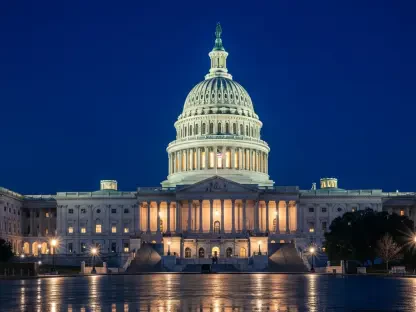In a world grappling with the escalating threat of climate change, China stands as a pivotal player due to its status as the planet’s largest carbon emitter, responsible for roughly a third of global greenhouse gas output, and its recent climate pledge has sparked intense debate. The announcement by President Xi Jinping during a virtual address to the United Nations on September 24 has drawn scrutiny from environmental and policy circles. China has pledged to slash emissions by 7-10 percent from their peak by 2035, while also aiming to increase non-fossil fuel energy consumption to over 30 percent and dramatically expand wind and solar capacity. However, this target has been met with a chorus of criticism, with many experts branding it as underwhelming and insufficient to meet the urgent demands of the climate crisis. This article delves into the nuances of China’s latest climate commitment, examining whether it represents a genuine step forward or merely a symbolic gesture that fails to address the scale of the challenge at hand.
Scrutinizing the Scale of Ambition
The newly unveiled climate target from China has drawn sharp rebuke from experts who argue it lacks the boldness necessary to combat global warming effectively. Analysts such as Bill Hare of Climate Analytics have described the proposed 7-10 percent reduction in emissions as “disappointing,” emphasizing that it falls drastically short of the Paris Agreement’s goal to limit temperature increases to 1.5 degrees Celsius above pre-industrial levels. The Centre for Research on Energy and Clean Air has calculated that a reduction closer to 30 percent is required to align with these international standards. Critics contend that China’s pledge might not even push beyond the reductions already projected under existing policies, casting doubt on whether this target reflects a serious commitment to transformative change in the face of mounting environmental threats.
Further scrutiny reveals a broader concern among climate advocates about China’s role as a global leader in emissions reduction. The modest scale of the target has led to fears that it could undermine international efforts to curb catastrophic warming, especially given China’s significant contribution to global emissions. Li Shuo from the Asia Society Policy Institute has echoed this sentiment, labeling the goal as “underwhelming” and suggesting it fails to demonstrate the level of ambition expected from a nation with such outsized influence on the planet’s climate trajectory. This lack of aggressive action raises critical questions about whether China is prepared to take on the leadership mantle needed at this juncture, particularly as other major economies waver in their commitments to sustainable progress.
Navigating the Fog of Uncertainty
A significant point of contention surrounding China’s climate pledge is the ambiguity embedded within its framework. Essential details, such as the precise definition of “peak emissions” and the specific base year from which reductions will be measured, remain undisclosed, leaving room for interpretation and skepticism. Some analysts speculate that emissions might have already peaked or will do so imminently, but others caution that recent declines could be attributed to temporary factors like economic slowdowns during the COVID-19 pandemic rather than lasting structural shifts toward cleaner energy. This uncertainty, as highlighted by Andreas Sieber of 350.org, erodes confidence in the enforceability and impact of the target, making it difficult to assess its true potential.
Beyond the lack of clarity on emissions metrics, the absence of a detailed implementation plan adds another layer of doubt. Without transparent timelines or specific policy mechanisms to achieve the stated goals, stakeholders are left questioning how China intends to transition its massive economy away from carbon-intensive practices. This vagueness not only hampers international efforts to hold China accountable but also diminishes the credibility of the pledge as a cornerstone of global climate strategy. As discussions unfold, the need for concrete answers becomes increasingly apparent, with many urging Beijing to provide a clearer roadmap to dispel doubts and foster trust among global partners striving for a unified response to climate challenges.
Balancing Coal and Clean Energy Dynamics
China’s role in the global climate landscape is marked by a striking contradiction that shapes perceptions of its latest target. On one side, the nation remains heavily reliant on coal, approving nearly 100 gigawatts of new or revived coal power projects last year, the highest in a decade, which starkly contrasts with decarbonization goals. This persistent investment in fossil fuels, which still fuel a significant portion of China’s energy grid, raises serious concerns about the feasibility of achieving meaningful emissions cuts. Such actions paint a picture of a country caught between economic imperatives and environmental responsibilities, often prioritizing short-term growth over long-term sustainability.
On the flip side, China emerges as a formidable force in renewable energy, leading the world in the production of solar panels, electric vehicles, and wind turbines, with market shares that dominate global supply chains. Data from international energy bodies reveal that China accounts for a substantial portion of clean tech manufacturing, positioning it as a potential catalyst for widespread adoption of sustainable practices. Experts like Li Shuo argue that this leadership in clean technology could enable China to surpass its conservative targets if strategic focus shifts decisively toward renewables. This duality underscores the complex narrative of a nation at a crossroads, capable of either stalling or accelerating global progress depending on its policy priorities.
Finding Hope in Conservative Targets
Amid the wave of criticism, a thread of cautious optimism persists among some climate observers regarding China’s approach. Analysts like Yao Zhe from Greenpeace East Asia point out that China has a history of setting conservative targets it can reliably achieve, often exceeding expectations through on-the-ground progress. Data from Greenpeace suggests that emissions from the power sector could peak imminently, driven by the rapid expansion of renewable energy infrastructure. This perspective offers a counterpoint to the prevailing skepticism, hinting that economic trends and technological advancements might deliver deeper reductions than the official 7-10 percent cut suggests, potentially reshaping China’s climate impact.
This guarded hope is further fueled by the recognition of China’s capacity to innovate and scale solutions swiftly when conditions align. The nation’s ability to deploy renewable energy projects at an unprecedented pace could serve as a game-changer, even if the current pledge appears modest on paper. While critics remain wary of over-reliance on future overperformance, there is an acknowledgment that China’s trajectory in clean energy adoption provides a foundation for more ambitious outcomes. This dynamic highlights the importance of monitoring actual implementation over stated goals, as the real test of commitment lies in tangible results rather than initial promises.
Weighing Global Expectations and Leadership
The timing of China’s climate announcement adds a critical dimension to the ongoing debate, particularly in light of shifting international dynamics. With the United States having retreated from climate leadership during former President Donald Trump’s tenure, which openly dismissed climate science, global attention has turned sharply toward China to fill the void. As a major economic and political power, China’s actions carry disproportionate weight in shaping the trajectory of international climate efforts. The 7-10 percent reduction target, while a historic acknowledgment of the need for cuts, is widely seen as a missed opportunity to assert decisive leadership when the world is in dire need of bold, unifying action.
Moreover, the heightened scrutiny on China reflects broader expectations for it to leverage its influence and resources to drive systemic change. The global community is keenly aware that without substantial contributions from the largest emitter, achieving the Paris Agreement’s objectives becomes increasingly elusive. This context amplifies the disappointment surrounding the current pledge, as many had hoped for a target that would galvanize other nations into stronger commitments. As international pressure mounts, China faces a pivotal moment to redefine its role, balancing domestic priorities with the urgent call to steer collective efforts toward a sustainable future.
Reflecting on Missed Opportunities
Looking back, the unveiling of China’s climate target stirred a complex mix of reactions, with disappointment overshadowing initial hopes for a groundbreaking commitment. The modest 7-10 percent emissions reduction by 2035 was critiqued for lacking the depth required to align with global climate imperatives, while ambiguities in its framework further clouded its potential impact. Despite these shortcomings, China’s dominance in renewable energy offered a faint promise of exceeding expectations through practical advancements. Moving forward, the focus should shift to pressing for greater transparency and more aggressive policies from Beijing, encouraging the nation to harness its clean tech prowess as a catalyst for change. Additionally, international collaboration must intensify to support and challenge China in equal measure, ensuring that its pivotal role translates into meaningful progress. The path ahead demands not just symbolic gestures but concrete actions to bridge the gap between current pledges and the urgent needs of a warming world.









